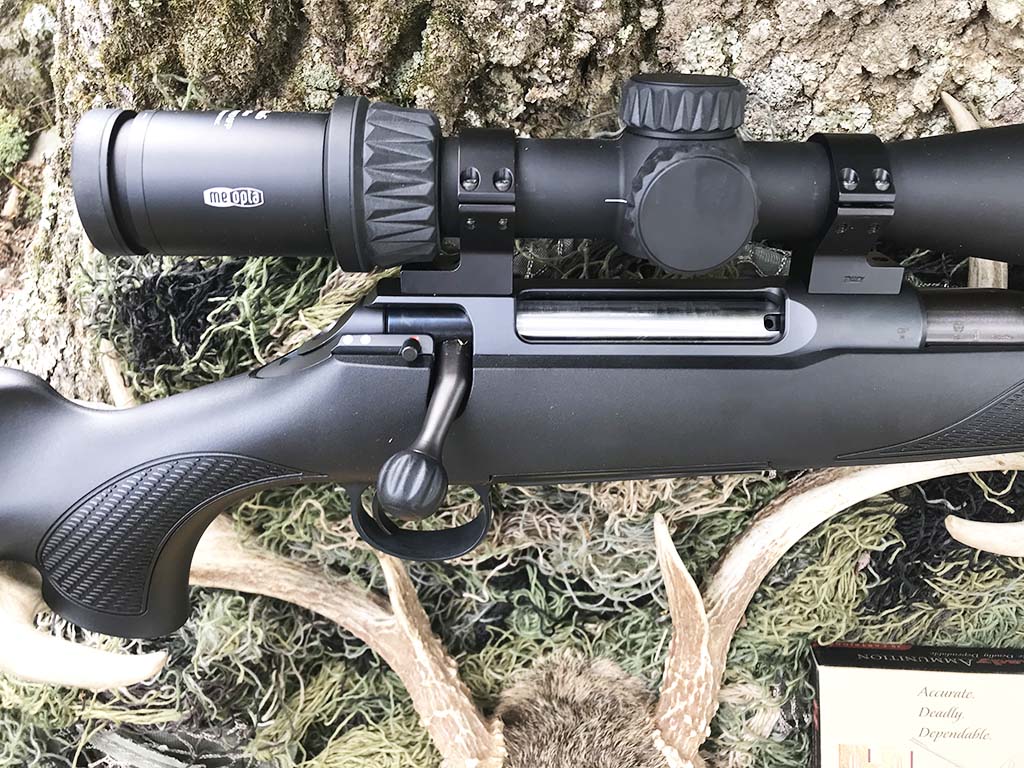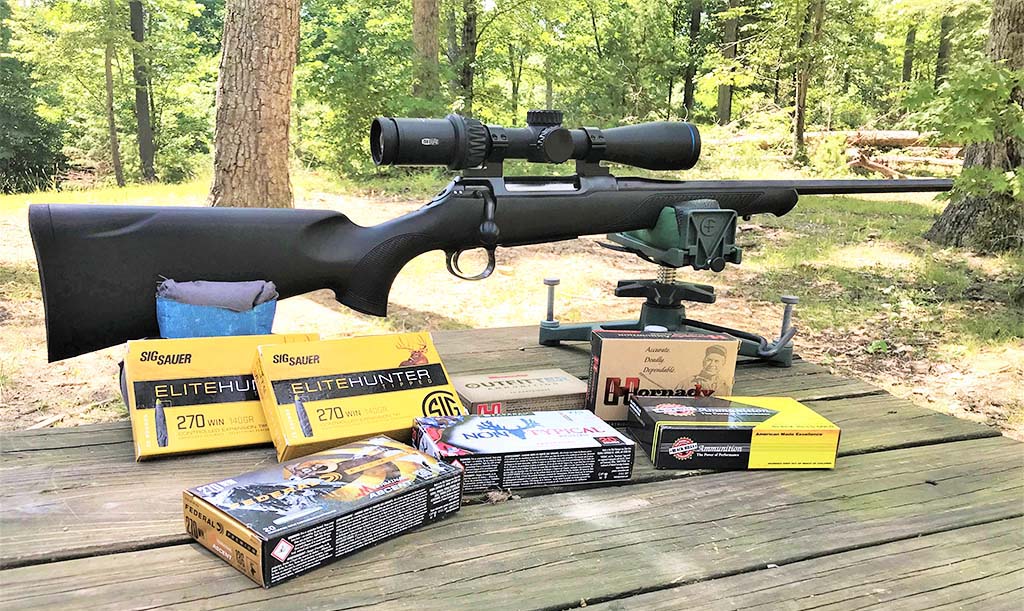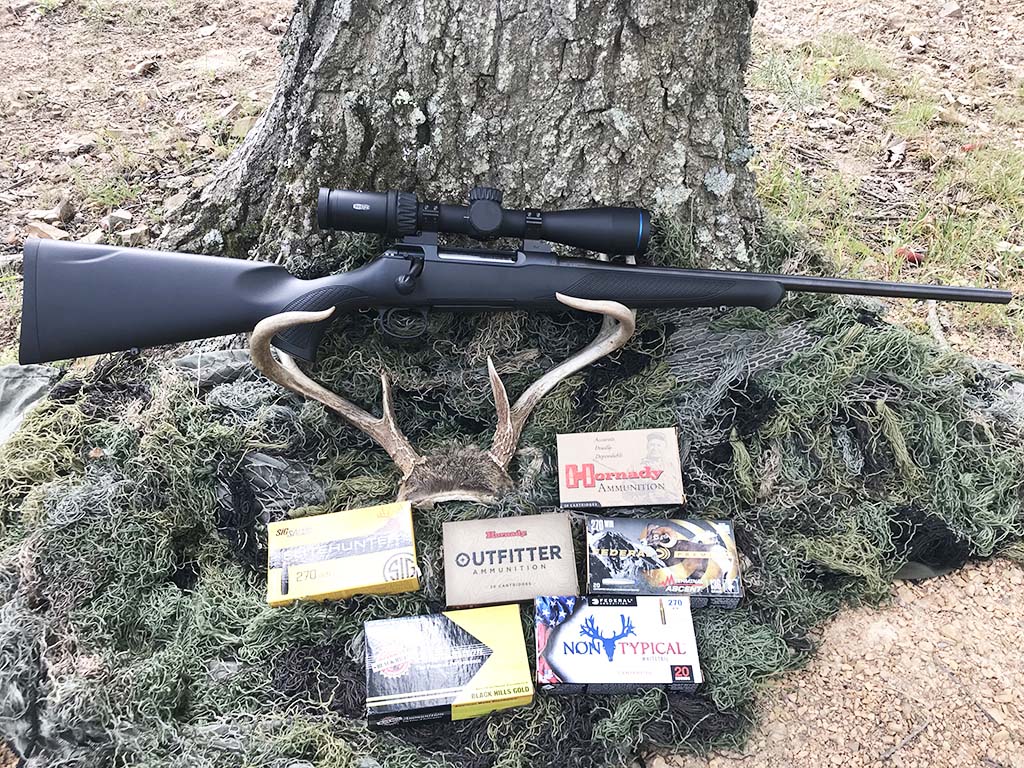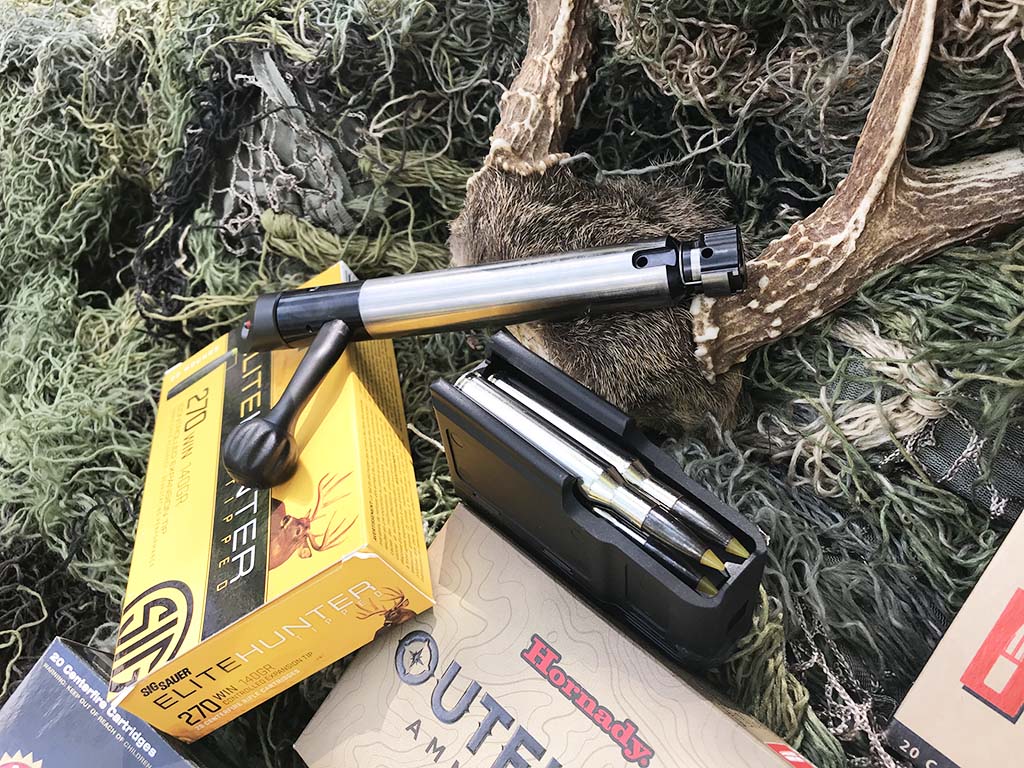By Todd Burgreen –
What comes to mind if J.P. Sauer & Sohn (Sauer) bolt action is mentioned? Old World craftsmanship and a commensurate price tag are two immediate thoughts. After all, Sauer has the distinction of being the oldest active firearm manufacturer in Germany. While you would be right, as Sauer certainly offers high-end refined weapons, Sauer corporate leadership also has decided to offer a more economical bolt action. U.S. hunters would be advised to consider the Sauer 100 as it benefits greatly from Sauer’s experience with higher end rifle offerings.
In designing the Sauer 100 lineup, the company wanted to build the best bolt-action hunting rifles in what many label the “affordable class.” As many features as possible were incorporated by Sauer, believing hunters would appreciate and choose accordingly. Multiple Sauer 100 models exist with the Sauer Classic XT tested for this submission.
The 100 Classic XT features a synthetic stock. The 100 Classic XT uses an ERGO MAX stock with a similar design of the pricier SAUER 101 and 404 rifles, complete with the distinctive Schnabel forend. The slight palm swell is textured along with the forend. A spring-loaded detachable magazine fits flush with the bottom of the stock. The MOA guarantee is also sure to garner attention. The SAUER 100 Classic XT is an “entry level/affordable” rifle that is by no means basic.

That J.P. Sauer intended the 100 model series for the U.S. market is evident by the barrel attachment method used. Most European rifle manufacturers heat the receiver and press-fit the barrel in place versus the American barrel attachment method of being screwed and torqued in place. U.S. consumers prefer having the ability to re-barrel—even if most do not ever take advantage of this ability. However, J.P. Sauer still could not resist a little European design flare when it comes to bolt lock up in the receiver. The Sauer 100 Classic XT receiver doesn’t have the lug abutments cut into the receiver like almost every American bolt-action design. Sauer cuts a recess in the receiver and then puts a breech ring in place. The bolt lugs sit against this breech ring when the action is closed; the front of the breech ring acts as an index point for the barrel. The barrel can just be screwed into the receiver until it touches the breech ring, and headspace will be correct. The front of the breech ring gives the barrel a known stopping point in relation to the lug abutments to ensure headspace is the same every time. No hand-fitting is necessary. The consumer and manufacturer benefit from this procedure. The consumer is rewarded with tight tolerances; the manufacturer with a system that does not require specially trained personnel to implement proper headspacing. Welcome to the age of CNC-based methods.
The 100 Classic XT is comprised of Sauer’s building blocks for accuracy and reliability. The Sauer receiver houses a one-piece, three-lug profile bolt. This bolt pattern is often associated with entry-level bolt actions. However, the secret is out … this configuration can be conducive to accuracy. We can debate as to why. My theory is that by being more practical for manufacture in our CNC age, quality exceeds expectations compared to more traditional bolt-action designs where skilled craftsman must hone/finish the process of fitting properly. Remember the barrel ring detail from above? Frankly, skilled craftsmen are in short supply no matter the efforts to get employees trained up.

One advantage of the three-lug bolt is short handle throw, 60 degrees with the 100 Classic XT, allowing for easier scope mounting and less rotation/friction to unlock bolts from the chamber during manipulation. A three-position safety is mounted on the right side of the action behind the bolt handle. The bolt can be cycled with the safety engaged, which is always in terms of safety. The three-lug bolt geometry enables rounds to be “scooped” up out of the double-stack detachable magazine with a capacity of 5+1 for the .270Win.
Sauer’s attention to detail is present in the bolt head via dual ejectors and extractor location. The 100 has dual plunger ejectors that sit opposite a blade extractor sitting low in the ejection port during bolt travel. This arrangement yields optimal extraction and ejection. Dual ejectors mean the ejection process is very controlled, and the angle at which the fired case leaves the action is shallow. This prevents issues with empty cases striking scope windage turrets sitting low over the receiver where they need to be for proper cheek weld.
The J.P. Sauer cold-hammer-forged barrel, adjustable trigger and Sauer EVER REST bedding system round out the details for the 100 Classic XT. Sauer hammer forged barrels are renowned for their accuracy. The Sauer 100 Classic XT benefits greatly from a barrel quality upgrade well above its commensurate price tag. The Sauer 100 Classic XT’s barrel comes off the same hammer forge machines as higher end Sauer rifles. Blaser and Mauser rifle barrels are also made on these machines. The adjustable trigger can be set from 2.2 to 4.2 pounds. The action bedding system of the Sauer 100 Classic XT is refined European with nothing equivalent in the U.S. market. There is no recoil lug as we know it on the action. A groove is machined in the action behind the forward action screw that mates up with a corresponding aluminum block in the stock when receiver and stock are mated together.

100 Classic XT Chambered in .270Win
The overall length of the SAUER 100 Classic XT is 42 inches with the free-floated, slim-profile, 22-inch barrel. Its weight is 6.85 pounds. A 100 Classic XT chambered in .270 Winchester (.270 Win) was evaluated for this article. Multiple other calibers are available ranging from .223 Rem up to .300 Win Mag with many stops in between.
The .270 Win was the darling of performance way back in the 1920s! The .270 Win has been around since 1925 and has generated a dedicated following. What is not to love about a 130-grain bullet traveling at 3,100+ feet per second (fps)? Very few chamberings equal the soon-to-be, 100-year-old .270 Win. as a pure hunting cartridge. The difference lies in case dimensions allowing for higher velocities to be obtained with .270 Win 130- or 140-grain bullets. Simply put, few rounds can equal the velocity or downrange energy yields of the .270 Win at typical game engagement distances.
Scope
The scope selection was agonized over as this author did not want to put an anchor on the lightweight Sauer 100 Classic XT; yet he still wanted magnification range in order to take advantage of the accurate/potent .270 Win chambering. We are talking about true multipurpose roles: stalking game while maintaining long-range punch across a clearing. An important part of the accuracy equation is a quality optic to go along with a cartridge and rifle. Meopta’s Optika6 2.5-15x44mm was mated to the 100 Classic XT with 30mm Talley rings. Talley rings are machined from solid 7075 T6 alloy and are a Match Grade in terms of tolerances. The Sauer 100 series rifles are compatible with Remington 700 LA scope accessories.
Meopta designed the Optika6 lineup to give hunters and shooters the quality features they desire in an affordable package. Most European optic manufacturers are not known for this. For example, MeoBright and MeoShield offer lens coatings to eliminate glare and reflections to deliver 91% daylight light transmission while protecting from scratching or abrasion, an illuminated etched RD reticle system, DichroTech reticle, 30mm tube construction, zero reset turrets, waterproof, fogproof and shockproof, and a lifetime warranty.

Bench Testing
A rifle that shoots well off the bench instills confidence when field practice starts or more importantly in the woods when stalking game. Testing was conducted with Black Hills Gold 130-grain TSX, SIG Sauer Elite 140-grain Controlled Expansion Tip and Hornady Superformance 130-grain SST and GMX loads. The Sauer 100 Classic XT trigger was a superb single-stage affair. Bench testing was done off a Caldwell tripod front rest and rear sandbag. The accuracy figures are based on firing three five-round groups and averaging group sizes. The Black Hills, SIG Sauer and Hornady loads produced groups no larger than 1.25-inches with most in the ¾-inch range.
Jungle Walk
After bench testing, the fun started with the Sauer 100 Classic XT in the form of various T&E scenarios. The 100 Classic XT with its portability is intended for stalk or still hunting forays. This translates into fluid off-hand shots at game. The Echo Valley Training Center’s (EVTC) Jungle Walk Range was used to get a sense of handling. Targets were set up randomly along the meandering trail. A shooter moves down the path until his partner points out a target for engagement albeit paper, clay pigeon or steel. The ability to move through varied terrain and engage randomly placed targets suits the Sauer 100 Classic XT perfectly. If lucky, the hunter will be able to adopt a kneeling or sitting position in lieu of pure off-hand. Even better is gaining advantage of support from a tripod or shooting sticks. BOG Great Divide and Death Grip tripods were brought along for this part of testing. Each proved their worth many times over, especially as engagement distances increased.
Easy to Handle; Easy on the Budget
The 6.85-pound, 22-inch barrel Sauer 100 Classic XT proved easy to handle with no searching for targets required when the rifle was brought up to the shoulder. Accuracy exceeded expectations during bench testing and in the field. The Sauer 100 Classic XT is not a compromise candidate in terms of performance. A user will benefit from purchasing it by having funds left in the budget for optics, ammunition and other gear. The Sauer 100 Classic XT equipped with a Meopta optic proves you do not need a multi-thousand-dollar rig to have a potent set up.
FOR MORE INFORMATION:
J.P. Sauer & Sohn: jpsauer-usa.com
SIG Sauer: sigsauer.com
Hornady Manufacturing: hornady.com
Meopta Optics: meoptasportsoptics.com
Echo Valley Training Center: echovalleytraining.com
Black Hills Ammunition: black-hills.com
Bog: boghunt.com
| This article first appeared in Small Arms Review V25N2 (February 2021) |












